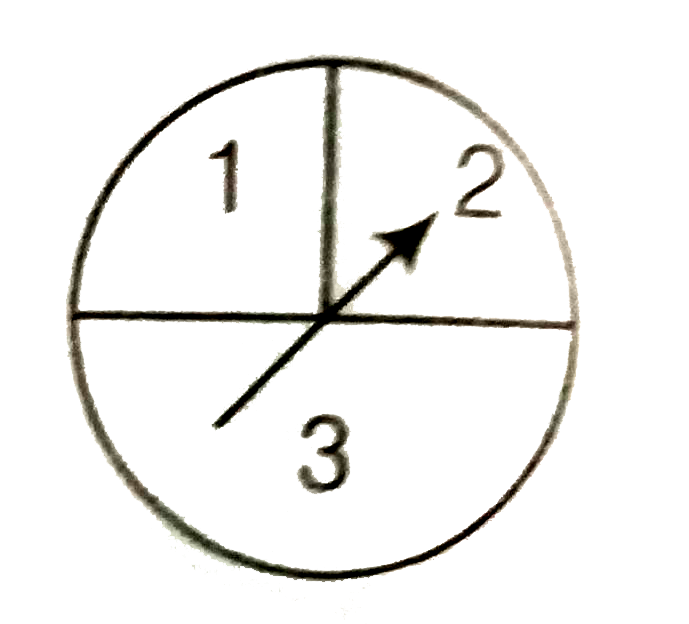A game of chance consists of spinning an arrow which comes to rest pointing at one of the numbers 1, 2, 3, 4, 5, 6, 7, 8 (See Fig. 131), and these are equally likely outcomes. What is the probability that it will point at (i) 8? (ii) an odd number? (iii) a number greater than 2? (iv) a number less than 9?
To solve the problem step by step, we will calculate the probability for each part of the question.
Given:
The possible outcomes when spinning the arrow are the numbers: 1, 2, 3, 4, 5, 6, 7, 8.
Total number of outcomes (n) = 8.
(i) Probability that it will point at 8:
- Favorable outcomes: There is only 1 favorable outcome, which is the number 8.
- Probability (P) = Number of favorable outcomes / Total number of outcomes = 1 / 8.
(ii) Probability that it will point at an odd number:
- Favorable outcomes: The odd numbers in the set are 1, 3, 5, and 7. So, there are 4 favorable outcomes.
- Probability (P) = Number of favorable outcomes / Total number of outcomes = 4 / 8 = 1 / 2.
(iii) Probability that it will point at a number greater than 2:
- Favorable outcomes: The numbers greater than 2 are 3, 4, 5, 6, 7, and 8. So, there are 6 favorable outcomes.
- Probability (P) = Number of favorable outcomes / Total number of outcomes = 6 / 8 = 3 / 4.
(iv) Probability that it will point at a number less than 9:
- Favorable outcomes: All the numbers (1, 2, 3, 4, 5, 6, 7, 8) are less than 9. So, there are 8 favorable outcomes.
- Probability (P) = Number of favorable outcomes / Total number of outcomes = 8 / 8 = 1.
Summary of Results:
1. Probability of pointing at 8 = 1/8
2. Probability of pointing at an odd number = 1/2
3. Probability of pointing at a number greater than 2 = 3/4
4. Probability of pointing at a number less than 9 = 1
The possible outcomes when spinning the arrow are the numbers: 1, 2, 3, 4, 5, 6, 7, 8.
- Favorable outcomes: There is only 1 favorable outcome, which is the number 8.
- Probability (P) = Number of favorable outcomes / Total number of outcomes = 1 / 8.
- Favorable outcomes: The odd numbers in the set are 1, 3, 5, and 7. So, there are 4 favorable outcomes.
- Probability (P) = Number of favorable outcomes / Total number of outcomes = 4 / 8 = 1 / 2.
- Favorable outcomes: The numbers greater than 2 are 3, 4, 5, 6, 7, and 8. So, there are 6 favorable outcomes.
- Probability (P) = Number of favorable outcomes / Total number of outcomes = 6 / 8 = 3 / 4.
- Favorable outcomes: All the numbers (1, 2, 3, 4, 5, 6, 7, 8) are less than 9. So, there are 8 favorable outcomes.
- Probability (P) = Number of favorable outcomes / Total number of outcomes = 8 / 8 = 1.
1. Probability of pointing at 8 = 1/8
2. Probability of pointing at an odd number = 1/2
3. Probability of pointing at a number greater than 2 = 3/4
4. Probability of pointing at a number less than 9 = 1
Topper's Solved these Questions
Similar Questions
A game of chance consists of spinning an arrow which comes to rest pointing at one of the numbers 1,2,3,4,5,6,1,8 (see Figure), and these are equally likely outcomes. What is the probability that it will point at(i) 8?(ii) an odd number?(iii) a number greater than 2?(iv) a number less than 9?
View SolutionA game consists of spinning an arrow which comes to rest pointing at one of the numbers 1,2,3,4,5,6,7,8,9,10,11,12. If the outcomes are equally likely, find the probability that the pointer will point at an even number.
View SolutionA game consists of spinning an arrow which comes to rest pointing at one of the numbers 1,2,3,4,5,6,7,8,9,10,11,12. If the outcomes are equally likely, find the probability that the pointer will point at a prime number.
View SolutionA game consists of spinning an arrow which comes to rest pointing at one of the numbers 1,2,3,4,5,6,7,8,9,10,11,12, as shown below.

If the outcomes are equally likely, find the probability that the pointer will point at :
(i) a number greater than 8.
View SolutionA game consists of spinning an arrow which comes to rest pointing at one of the numbers 1,2,3,4,5,6,7,8,9,10,11,12. If the outcomes are equally likely, find the probability that the pointer will point at a number between 3 and 11.
View SolutionA game consists of spinning an arrow which comes to rest pointing at one of the numbers 1,2,3,4,5,6,7,8,9,10,11,12. If the outcomes are equally likely, find the probability that the pointer will point at a number less than or equal to 9.
View SolutionA game of change consists of spinning an arrow which is equally likely to come to rest pointing to one of the number, 1, 2, 3, .., 12 as shown in Fig. 13.3. What is the probability that it will point to: (FIGURE) (i) 10? (ii) an odd number?
View SolutionA game consists of spining an arrow which comes to rest pointing at one of regions (1,2 or 3) (see figure). Are the outcomes 1,2 and 3 equally likely to occur? Give reason

View SolutionIn a throw of a single dice, find the probability of getting:
(i) a multiple of 2
(ii) an odd number
(iii) a number greater than 3.
View SolutionA die is thrown. Find the probability of getting: (i) an even prime number (ii) a number greater than 5 (iii) a number lying between 2 and 6
View Solution
